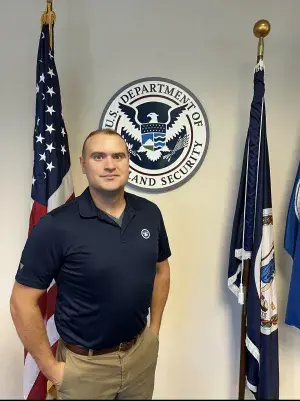
Chris Scott approaches every incident with equal parts of empathy and discretion.
As an insider threat analyst for TSA’s Law Enforcement/Federal Air Marshal Service, Scott reviews referrals and incidents that exhibit potential risk indicators of an insider threat and provides data collection and analytic support for the Insider Threat program.
“I genuinely treat each of my insider threat inquiries and assessments with care,” said Scott. “More importantly I am thorough. I treat the reported anomalies and the person of interest with the mindset, ‘What if the person was me? What level of care and discretion would I hope someone used when assessing me?’”
Don’t confuse the empathy Scott exhibits as weakness. On the contrary, it’s one of his strengths and a good reason why employees should feel confident reporting articulable concerns to his office. The tight hold and need to know aspect of the process are ironically why his job might be viewed skeptically.
“(Reporting) can be intimidating,” he admits. “I think a lot of people are reluctant to report something suspicious involving a colleague because they're afraid to be wrong. There are many things that may look anomalous or suspicious, but once additional information is obtained and assessed from multiple perspectives, it may not be that anomalous after all.”
Discussing the objective and fair processes of the program throughout September, recognized as National Insider Threat Awareness Month, helps destigmatize reporting.
Scott recognizes the sensitivity of his work and remains committed to objectively gathering facts through coordinating with stakeholders across TSA. “When conducting an inquiry, I am cautious because the last thing I want to do is cause undue harm.”
Building Partnerships
Scott’s intentional about building rapport with TSA program offices, aviation, pipeline, mass transit, freight and rail stakeholders with whom he and the insider threat team work.
“The goal is creating a culture of awareness and mindfulness of how potential threats arise and early intervention to prevent them,” said Scott. “We’re like switchboard operators. We take a 360-degree holistic approach to assessing an insider, and we connect with appropriate resources to report our findings.”
Scott stresses the importance of being observant to the changing behaviors of people with whom you interact. Sometimes destructive behaviors start in small, subtle ways that if detected early, can be addressed before major harm occurs.
“We can identify potential risk indicators,” explained Scott. “Let’s say somebody’s going through a rough spot. If they haven’t made a referral to the Employee Assistance Program, we can help in getting them those kinds of services.”
Tours in Afghanistan and Iraq cultivated empathy, discretion
As a bored and unchallenged high school underclassman, Scott found purpose once he was introduced to chemistry and physics in his junior and senior years. With acceptance into a good pre-med program not in the cards, he opted for a more non-traditional route to medicine.
Prior to joining TSA’s Insider Threat Section in 2017, Scott served 11 years in the U.S. Navy as a hospital corpsman, with deployments to Afghanistan and Iraq.
“Being afforded the opportunity at such a young age to be immersed in a very unique, culturally different environment and witnessing first hand true oppression emboldened my empathy, sympathy, and compassion for all persons,” said Scott.
He credits his knack of being relatable - no matter a person’s rank or position - on his maturation as a corpsman. At TSA, that translates to knowing his audience.
“I try my best to think about how policy could impact the workload of our employees and partners,” said a mindful Scott when working on insider threat policies and procedures. “There are many things that sound great in theory and look good on paper but can be problematic for personnel in the field.”
What I do matters
“Insider Threat is truly a program that belongs to each and every TSA and transportation industry person. I’m just one person who is fortunate enough to be a member of the office that manages the program. I believe the thing that matters most is our coordination efforts with all stakeholders across the agency, government and industry.
“We do our best to facilitate/coordinate channels of communication that are critical to the counter insider threat mission, but we can only be as effective as the information given to us. The true insider threat MVPs are our people who bring potential insider threat concerns to our attention, so that we can coordinate and assess effectively.”
By Karen Robicheaux, TSA Strategic Communications & Public Affairs

